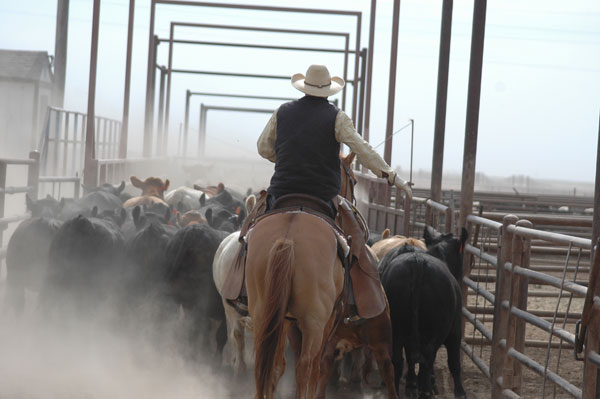Don’t confuse the concept of low stress with low pressure.

“We spend a lot of time with cattle in a feedyard. But we don’t necessarily spend the right time with the right cattle.” That’s how Ron Gill, program leader for the Texas AgriLife Extension Service, started out a cattle handling training session for feedyard cowboys recently. Gill’s training session on low-stress cattle handling was part of a Beef Quality Assurance (BQA) certification training for feedyard cowboys sponsored by the Texas Cattle Feeders Association.
In Gill’s opinion, backed by experience when he owned a preconditioning feedyard, is that incoming cattle need the most attention. That’s why he advocates an acclimation process for newly-arrived cattle.
Having an established acclimation process, where incoming cattle are worked every day for the first few days after arrival, pays off in several ways, Gill says. “To me, it’s one of the most beneficial things we can do form a quality assurance standpoint.”
Subscribe now to Cow-Calf Weekly to get the latest industry research and information in your inbox every Friday!
Gill learned the benefits of an acclimation procedure firsthand when he ran a preconditioning yard. He says his death loss and morbidity was unacceptable. “So we started to see if we could do something on the cattle handling side to make those cattle better.”
And it worked—death loss and morbidity both dropped significantly and average daily gain improved 0.25 pound a day. “To me, that’s worth a little effort, when we look at those kind of differences.”
The acclimation process doesn’t have to be long, he says. “We’re looking for 15 to 30 minutes a day, getting to where I can do what I want with the cattle, move them around and get them quieted and settled down.”
That’s where low-stress cattle handling comes in. “Just getting them to move and do what you want them to do, that’s stockmanship. But when I take stockmanship to the next level and use that to actually manage the psychology and well-being of an animal, that’s low-stress handling.”
However, he stresses that low-stress cattle handling is not low-pressure cattle handling. “Use the right pressure at the right time and make sure they have a place to go.”
While learning “the right pressure at the right time” takes time and experience, start by using the point of balance and flight zone. Demonstrating the concepts on a group of newly-arrived feeder cattle that clearly had more experience with coyotes and rattlesnakes than they did with humans, Gill showed the cowboys how to use the point of balance and flight zones to get the first few cattle in the bunch to move from one side of the pen to the other, working the cattle from the front and side rather than from behind.
“Working cattle from behind is not what they want us to do,” he says. That’s because, if you’re behind the cattle trying to drive them by waving your arms and shouting, those will turn round to see what the fuss is all about. “I want to work from the front, draw the cattle to me and let them take themselves out of the pen.”

70+ photos showcasing all types of cattle nutrition
Readers share their favorite photos of cattle grazing or steers bellied up to the feedbunk. See reader favorite nutrition photos here.
In addition to settling cattle down and allowing them to build trust in their handlers, Gill says the acclimation process has other benefits. “If I can do this when they first come in, I can look for sickness, lameness, anything that maybe ailing these cattle. If they’ll start relaxing, I can start picking up sickness as they come by.”
The key to an effective acclimation process is taking the time to work the cattle consistently so they build trust, relax in their new surroundings and go on feed quickly. Not only does it pay off throughout the time they’re in the feedyard, but when they ship as fed cattle. “I don’t want to do this they day they ship,” Gill says. “I want them all to work smooth and easy. The only way I can do that is to train them early.”
You might also like:
How to treat lump jaw disease in cattle
Breedback on first-calf heifers starts with nutrition
How to treat leg fractures in young calves
Picture perfect summer grazing scenes from readers
Enjoy a laugh on us with Rubes cow cartoons
How one farm made room on the ranch for nine sons
About the Author(s)
You May Also Like



